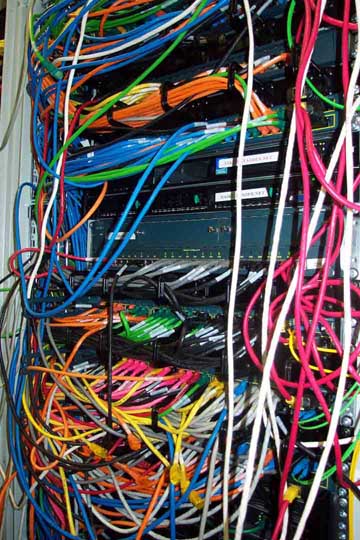Server Blades to replace conventional.
Everyone knows that the development of technology is spiraling and now we are at a new stage of it. I think everyone has heard and probably worked (s) with the so-called "blade servers"? In this topic, I would like to tell you a little about them, as well as what bonuses this type of server provides us.
In general, the server-blade is nothing new in terms of the architecture of server systems. Roughly speaking, these are tightly packed 1u in a big box, and in the box you can, besides the servers themselves, cram other hardware solutions in the form of blades. In general, the word blade reflects the essence of the super-thinness of various hardware and modules.

')
It is no secret that the “care” for the server is a painstaking process and probably in most server rooms, when you look behind the cabinet you ask yourself the question “And where is cho?”. It is estimated that for a fully clogged, 1u server (42 pieces), a rack requires 140 cables: power, kvm, network & etc., using a blade server requires ~ 3 cables, is better, isn't it? As a matter of fact, the transition to the blades servers is called up - with a higher proportion of packaging than 1u-2u -..., cheaper administration costs and power consumption.

Let's talk a little about blade server designs. In general, blade servers can be considered to consist of three main components:
1 — Chassis into which hot-swappable blade modules are inserted;
2 — server-type blade modules inserted into the chassis — a regular server, but in a special package;
3 - plug-in plug-in plug-in modules that can be replaced by server modules.
Server-type blade modules are at least one processor, RAM and disk memory.
The chassis can have a rear or midplane for accessing common infrastructure components: Ethernet / Fiber Channel / KVM switches, system ports, fans, and power supplies. What kind of hardware components are made common depends on the manufacturer.
Additional modules are used by server-type blade modules together and may include control, power supply, fans, and switch modules. These modules may have controllers for external devices, including. SCSI, Fiber Channel, disk arrays, iSCSI, Infiniband, etc. With fast communication channels, this allows you to build systems using SAN and NAS technologies.
These are the basic principles of blade servers, from which it is possible to more accurately understand the advantages compared to 1u-2u- ... servers.
So once again the advantages:
1 - a significant reduction in energy consumption => less power-> less heat-> less air-> less cabinets-> less space-> reduced TCO
2 - infrastructure flexibility due to modularity, simplification and integration
3 - 50-60% increase in utilization efficiency thanks to virtualization
The approximate cost of the chassis -2-3k $.
The approximate cost of the server module is $ 1-2,5k.
Payback for 2 years.
But what to do with the old 1u server?
In general, the server-blade is nothing new in terms of the architecture of server systems. Roughly speaking, these are tightly packed 1u in a big box, and in the box you can, besides the servers themselves, cram other hardware solutions in the form of blades. In general, the word blade reflects the essence of the super-thinness of various hardware and modules.

')
It is no secret that the “care” for the server is a painstaking process and probably in most server rooms, when you look behind the cabinet you ask yourself the question “And where is cho?”. It is estimated that for a fully clogged, 1u server (42 pieces), a rack requires 140 cables: power, kvm, network & etc., using a blade server requires ~ 3 cables, is better, isn't it? As a matter of fact, the transition to the blades servers is called up - with a higher proportion of packaging than 1u-2u -..., cheaper administration costs and power consumption.

Let's talk a little about blade server designs. In general, blade servers can be considered to consist of three main components:
1 — Chassis into which hot-swappable blade modules are inserted;
2 — server-type blade modules inserted into the chassis — a regular server, but in a special package;
3 - plug-in plug-in plug-in modules that can be replaced by server modules.
Server-type blade modules are at least one processor, RAM and disk memory.
The chassis can have a rear or midplane for accessing common infrastructure components: Ethernet / Fiber Channel / KVM switches, system ports, fans, and power supplies. What kind of hardware components are made common depends on the manufacturer.
Additional modules are used by server-type blade modules together and may include control, power supply, fans, and switch modules. These modules may have controllers for external devices, including. SCSI, Fiber Channel, disk arrays, iSCSI, Infiniband, etc. With fast communication channels, this allows you to build systems using SAN and NAS technologies.
These are the basic principles of blade servers, from which it is possible to more accurately understand the advantages compared to 1u-2u- ... servers.
So once again the advantages:
1 - a significant reduction in energy consumption => less power-> less heat-> less air-> less cabinets-> less space-> reduced TCO
2 - infrastructure flexibility due to modularity, simplification and integration
3 - 50-60% increase in utilization efficiency thanks to virtualization
The approximate cost of the chassis -2-3k $.
The approximate cost of the server module is $ 1-2,5k.
Payback for 2 years.
But what to do with the old 1u server?
Source: https://habr.com/ru/post/25416/
All Articles